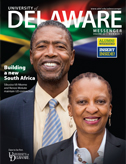Babies learn while on the go

RESEARCH | Watch a very young infant for a few minutes and you’ll see a lot of what looks like random arm flapping.
It turns out that these movements aren’t random at all—they’re a precursor to reaching, mouthing, batting and banging, all of which teach babies valuable lessons about cause-and-effect relationships and the properties of objects.
But what happens to children who are born with neurological or muscular deficiencies that prevent or limit this early movement and exploration?
“They’re at risk for future learning disabilities as well as difficulty with basic tasks like feeding and dressing themselves,” says Michele Lobo, research scientist and member of UD’s GoBabyGo team focused on infant mobility research.
With a grant from the National Institutes of Health, she and an interdisciplinary team are testing a novel device to help these infants. They will follow the progress of 20 babies born with brain injuries as they use an enhanced pediatric version of the commercially available Wilmington Robotic Exoskeleton (WREX). The device is worn like a vest and can selectively assist or resist antigravity arm movements based on the needs of an individual child.
“The research has two primary goals, one focused on the device as an assistive tool and the other evaluating its use for rehabilitation,” Lobo says.






